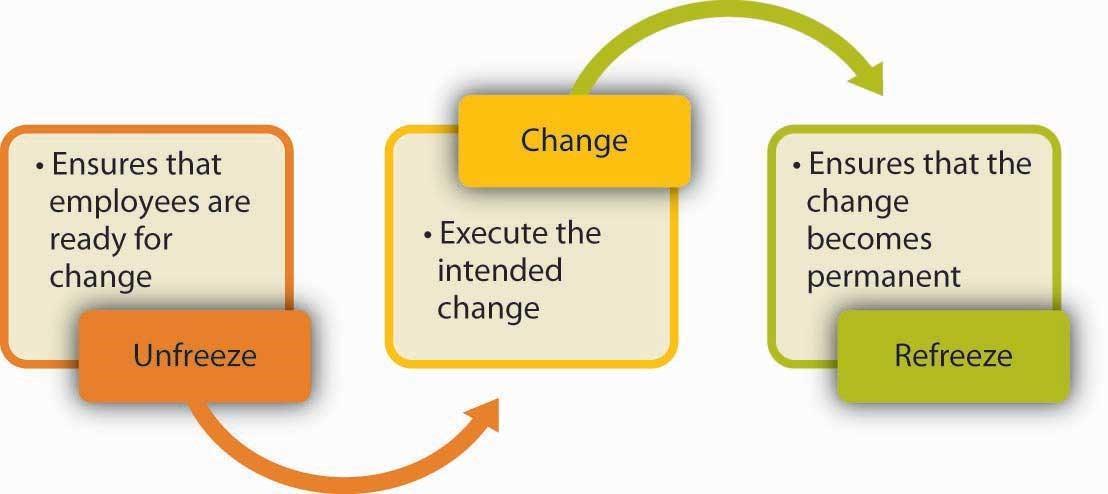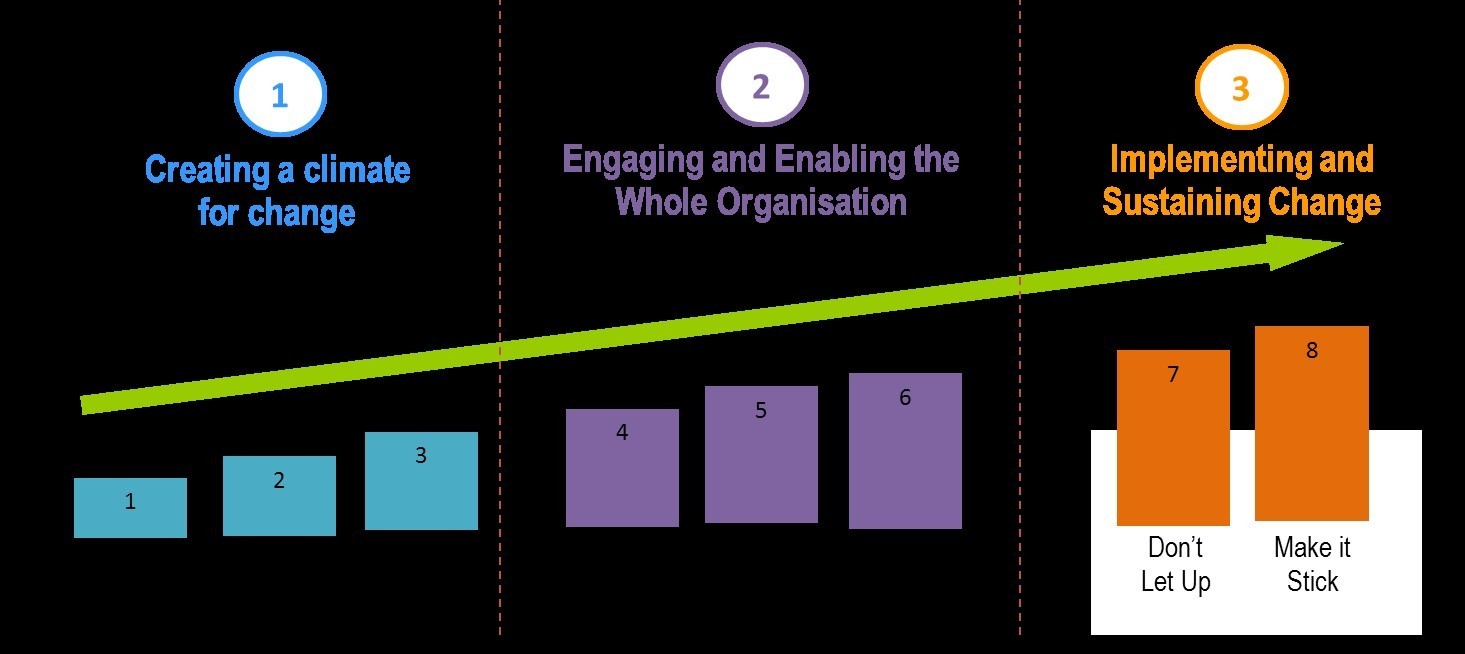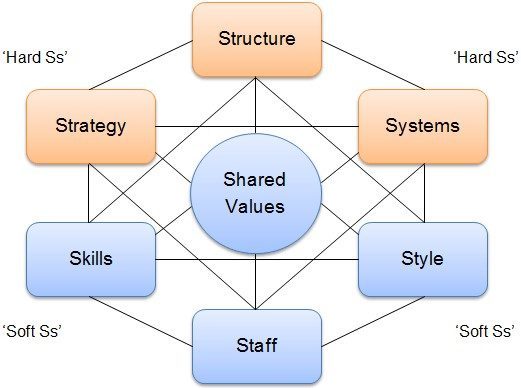Different Models of Change Management
| ✅ Paper Type: Free Essay | ✅ Subject: Human Resources |
| ✅ Wordcount: 2711 words | ✅ Published: 21 Dec 2017 |
Part of: Change Management
Introduction
This paper provides a critical discussion of the different models of change management with a focus on the models proposed by Kurt Lewin (1958), John Kotter (1995) and the McKinsey 7S model (1982) developed by Tom Peters and Robert Waterman.
Understanding Change
Given the wide diversity in the nature and type of change experienced by individuals and organisations, no single definition of change exists. However, there is a general consensus that change is a constant feature of organisational life (Bamford and Daniel, 2005), and that it is constantly increasing in terms of its frequency, magnitude and unpredictability (Burnes, 2009). Jones (2007) defined organisational change as the way in which organisations move from one state to another to increase their effectiveness, and Greenan (2003) stated that it involves a re-distribution of power, information and skills. Similarly, Saif et al (2013) assert that effective change management is essential for organisational development and ultimately survival, and yet studies have shown that around 60% of change initiatives fail (CIPD, 2015)
Signi¬cant work has been done to characterise the nature of change, the forces that drive it and the processes through which it can be achieved, and this has resulted in a number of models and theories that claim to capture change (Saif et al, 2013).
All approaches, however, are dependent to some extent on the wider strategic and environmental context in which an organisation operates. According to Pettigrew et al (1992) this context is the ‘why and when’ of change and takes account of the external context such as the current political, economic and social environment, and also the internal contextual factors such as organisational culture, structure and capabilities.
Lewin’s 3 Step Change Model
One of the most widely recognised of these change models was provided by Kurt Lewin (1958) who became the pioneer of planned change with the introduction of his “three-step change model” in the 1950s.
The steps in this model include: ‘unfreezing’- where the current equilibrium is destabilised to allow any old behaviours to be discarded and the desired new behaviours to be adopted; ‘moving’ – where individuals are supported to move from less acceptable to more acceptable behaviours through different change initiatives; and ‘re-freezing’ – where the new behaviours become embedded in every-day practice to allow stability at a new equilibrium as shown in Figure 1:
Figure 1 Lewin’s 3-Step Change Model

Source: Carpenter, Bauer and Erdogen, 2009
According to Cameron and Green (2009), Lewin’s model provides a useful tool for those considering organisational change, particularly when used in conjunction with his force field analysis technique which provides a focus for management teams to debate the resisting and driving forces for change. They claim that through using this model, a team can quickly move on to identifying the next steps in the change process.
However, Lewin’s model has attracted major criticism in that it assumes that organisations operate within a stable environment, it is a ‘top-down’ approach, and fails to give consideration to issues around organisational power and politics (Burnes, 2004). In addition, its linear approach has been found to be too inflexible in certain scenarios such as in times of instability and uncertainty in the external and internal environment (Bamford and Forrester, 2003). In addition, it has been claimed that such a model is only relevant to incremental and isolated change projects which therefore makes it unable to tackle transformational change (Dawson, 1994).
Kotter’s 8 Step Model
Lewin’s model has been adapted and re-created in many different forms (McWhinney, 1992). In particular, the work of John Kotter (1995) can easily be mapped against Lewin’s model (Higgs and Rowand, 2005), but instead provides a more practical eight-step approach to change management (Todnem By, 2005).
Kotter initially developed his change model by observing for-profit businesses, but it is claimed that it has applicability to public and third sector organisations also (Nitta et al, 2009).
Kotter’s model was based upon his observations of the main mistakes made in organisations which were seeking to transform themselves and he proposed eight key steps to success (see Figure 2):
Figure 2 Kotter’s 8 Step Model

Source: Adapted from: Department for Children, Schools and Families, 2009
Within Kotter’s model, the different steps are:
- Step 1: Increase Urgency: according to Bond (2007) this first step is important in generating the ‘activation energy’ to start the process of change. External pressures can help to achieve this sense of urgency such as legislative forces or threat of new competition. Kotter (1998) claimed that failure to adequately complete this step is one of the most frequent causes of failure overall.
- Step 2: Build the Guiding Team: with the sufficient power and influence to lead the change (Appelbaum et al, 2012).
- Step 3: Get the Right Vision: that clearly articulates what the change is, why it is needed and how it will be achieved.
- Step 4: Communicate Buy In: by telling all key stakeholders in a range of different ways the what, why and how of the change, so that they understand and support the change initiative.
- Step 5: Empower Action: by facilitating individuals to support the change. Successful change usually requires sufficient resources to support and ’empower’ the process (Fernandez and Rainey, 2006).
- Step 6: Create Short Term Wins: and giving recognition for the work done. Short-term wins provide visible evidence that the change is worth it and justified. Acknowledging these successes builds morale and momentum whilst also gaining crucial buy-in (Gupta, 2011).
- Step 7: Don’t Let Up: consolidate the gains achieved and create further momentum by developing people as change agents (Appelbaum et al, 2012).
- Step 8: Make it Stick: and anchor the change within the culture of the organisation. According to Fernandez and Rainey (2006), for change to be enduring, members of the organisation must incorporate the new practices into their daily routine.
Kotter’s model is generally considered to provide a practical and logical approach to managing change, and has been found to have a high level of appeal amongst managers with it still being used extensively today (Cameron and Green, 2009). However, despite this it has been criticised for a number of reasons. One of the key criticisms is that there is a lack of ‘follow through’ and that it ‘peaks too early’ (Cameron and Green, 2004). Other critics suggest that this approach is based on an often unfounded assumption that individuals will resist change (Kelman, 2005), and that where resistance does occur, there is insufficient explanation of the reasons why (King and Anderson, 2002). In addition, Sidorko (2008) argues that Kotter makes no concessions to the fact that his model is ordered sequentially and that all steps must be followed. He claims that from his study of organisational change and the use of the model, there is often a need to build multiple guiding coalitions on multiple occasions which is something that Kotter fails to acknowledge.
Both Lewin’s and Kotter’s models focus specifically on planned change and it is this factor that is the target of most criticism. It is claimed that their models are inadequate in a range of circumstances, particularly where the given change is just one of a multiplicity of changes happening within the organisation (Carnall, 2007).
Similarly, other critics argue that change cannot be viewed as a linear sequence which can be applied to processes that are in reality ‘messy and untidy’ (Buchanan and Storey, 1997).
McKinsey 7S
The McKinsey 7S Model was developed in the early 1980s by Tom Peters and Robert Waterman. It is differentiated from other change theories as instead of proposing steps that must be taken in a particular order, the framework looks at the separate elements and how well they work and interact with each other). The 7S in the model describes the seven variables, termed ‘levers’ which form the framework (Peters and Waterman, 1982), as shown in Figure 3:
Figure 3 The McKinsey 7S Model

Source: Jurevicius, 2013
In Figure 3, it can be seen that the seven ‘S’ variables include:
- Strategy: which is the plan that is formulated to sustain competitive advantage
- Structure: which is the way the organisation is structured and its reporting mechanisms
- Systems: are the daily activities employees undertake to get the job done
- Shared Values: are the organisation’s core values that are demonstrated in the corporate culture
- Style: refers to the leadership style adopted
- Staff: are the employees
- Skills: the skills and competencies of the individual employees.
‘Shared Values’ are located in the centre of the model, to highlight that these are central to the development of all the other critical components, and the seven interdependent factors which are categorised as either ‘hard’ or ‘soft’ elements. The hard elements are easier to identify and can be directly influenced including strategy, structure and systems. The soft elements are much less tangible and are more influenced by organisational culture.
One of the benefits of the model is that is can be used to understand how the different organisational elements are interconnected and so how a change in one area can impact on the others. To be effective, an organisation must have a high degree of internal alignment amongst all of the seven Ss – each must be consistent with and reinforce the others (Saif et al, 2013). In addition, according to Rasiel and Friga (2002), the benefits of the McKinsey 7S model include the fact that it provides a diagnostic tool for managers to identify areas that are ineffective and combines the rational and hard elements of organisations alongside the softer, more emotional elements.
Criticisms of the McKinsey 7S model, however, claim that it does not offer any guidance on how to proceed once any areas of non-alignment have been identified (Grant, 2008). In addition, Bhatti (2011) argues that the model fails to take account of the importance of resources. Without additional resources such as finance,
information, technology, and the time, any change initiative cannot be effectively implemented (Higgins, 2005).
Discussion
According to Sidorko (2008) all of these change models have a role to play in supporting organisational change, but advises that they must be implemented cautiously and complemented with effective leadership. He claims that without such leadership, the models are merely a strict prescription for change that may not fit the organisation’s needs and which may result in more harm than good.
He claims that instead of applying such change models prescriptively, they should instead be used selectively and adaptively to accommodate the culture and environment of the organisation. This view is supported by Graetz and Smith (2010) who claim that in practice, it may be useful to account for contextual variables and adapt chosen change models accordingly.
MacBryde et al (2014) claim that change models such as those examined in this paper, are too abstract for practical application, and are generalised to the extent where they are at risk of missing the actual detail of what is happening. A further criticism of change management models in general, is that there is a lack of evaluation built into the process and yet critics claim that such evaluation is key to successful and sustainable change (Moran and Brightman, 2000).
Conclusion
In conclusion, this paper has provided a critical discussion of some of the most commonly cited change management models. It is evident that all three have been considered to have some practical benefit in terms of aiding the process of change in organisations and our understanding of it, and across all three models, it is clear that there is a high level of commonality amongst them.
However they have all been subjected to criticism due to their abstract nature. It has been argued that they oversimplify the process of change, lack evaluation, and do not take sufficient account of the often turbulent business context and environment in which organisational change occurs. In addition, it is clear that no matter how robust the change model, it will be ineffectual unless complemented by effective leadership.
It has been proposed that given this, change models such as those provided by Lewin, Kotter and the McKinsey 7S, should be used as a guide rather than a panacea, and applied flexibly to best match the culture and environment of the organisation and the nature of the change itself.
References
Appelbaum, S.H., Habashy, S., Malo, J.L. and Shafiq, H. (2012) “Back to the future: revisiting Kotter’s 1996 change model”, Journal of Management Development, Vol. 31 (8), pp. 764-782.
Bamford, D. and Daniel, S. (2005) “A Case Study of Change Management Effectiveness within the NHS”, Journal of Change Management, Vol. 5 (4), pp. 391-406.
Bamford, D.R. and Forrester, P.L. (2003) “Managing planned and emergent change within an operations management environment”, International Journal of Operations and Production Management, Vol. 23 (5), pp. 546 – 564.
Bhatti, O.K. (2011) “Strategy Implementation: An Alternative Choice of 8S’s”, Annals of Management Research, Vol. 1 (2), pp. 52-59.
Bond, M.A. (2007) Workplace chemistry: promoting diversity through organizational change, New England: University Press of New England.
Buchanan, D. A. and Storey, J. (1997). ‘Role-taking and role-switching in organizational change: the four pluralities’. In McLoughlin, I. and Harris, M. (Eds), Innovation, Organizational Change and Technology. London: International Thompson.
Burnes, B. (2009) Managing Change. 5th edn. Edinburgh: Pearson Education Limited.
Burnes, B. (2004) “Kurt Lewin and the Planned Approach to Change: A Re-appraisal”, Journal of Management Studies, Vol. 41 (6), pp. 977-1002.
Cameron, E. and Green, M. (2004) Making Sense of change management: a complete guide to the models, tools & techniques of organizational change, London: Kogan Page Publishers.
Carnall, C. A. (2007) Managing Change in Organizations. Essex: Person Education.
Carpenter, M., Bauer, T. and Erdogen, B (2009) Principles of Management, Flat World Knowledge available at: Available at: http://www.web-books.com/eLibrary/NC/B0/B58/047MB58.html
CIPD. (2015). Change Management, Chartered Institute of Personnel and Development. Available at: http://www.cipd.co.uk/hr-resources/factsheets/change-management.aspx
[accessed 22 May 2015].
Dawson, P. (1994) Organizational Change: A Processual Approach. Paul Chapman Publishing: London.
Day, G. and Leggat, S. (2015) Leading and managing health services, Melbourne: Cambridge University Press.
Department for Children, Schools and Families. (2009) Change Management Models. Available at: http://www.dcsf.gov.uk/everychildmatters/strategy/deliveringservices/servicedirectories/models/changemanagementmodels/
Fernandez, S. and Rainey, H. G. (2006) ‘Managing Successful Organisational Change in the Public Sector’, Public Administration Review, Vol. 66 (2), pp.168-176.
Grant, P. (2008) “‘The productive ward round’: a critical analysis of organisational change”, The International Journal of Clinical Leadership, Vol.16 (4), pp. 193-201.
Graetz, F. and Smith, A.C.T. (2010), “Managing organizational change: a philosophies of change approach”, Journal of Change Management, Vol. 10 (2), pp. 135-154.
Greenan, N. (2003) “Organisational change, technology, employment and skills: an empirical study of French manufacturing”, Cambridge Journal of Economics, Vol. 27 (2), pp. 287-316.
Gupta, P. (2011) “Leading Innovation Change – The Kotter Way”, International Journal of Innovation Science, Vol. 3 (3), pp. 141-149.
Higgs, M. and Rowland, D. (2005) ‘All Changes Great and Small: Exploring Approaches to Change and its Leadership’, Journal of Change Management, Vol. 5 (2), pp.121-151.
Higgins. J.M. (2005) “The Eight ‘S’s of Successful Strategy Execution”, Journal of Change Management, Vol. 5 (1), pp. 3-13.
Jones, G.R. (2007) Organisational Theory, Design, and Change, New Jersey: Pearson Prentice Hall.
Jurevicius, O. (2013) McKinsey 7s Model. Available at: http://www.strategicmanagementinsight.com/tools/mckinsey-7s-model-framework.html
Kelman, S. (2005) Unleashing change: A study of organizational renewal in government, Washington, DC: Brookings Institution Press.
King, M. and Anderson, N. (2002) Managing Innovation and Change, Sydney: Thomson.
Kotter, J.P. (1995) “Leading Change: Why Transformation Efforts Fail”, Harvard Business Review, March-April, pp. 59-67.
Kotter, J.P. (1998) ‘Winning at Change’, Leader to Leader, Vol.10, pp.27-33.
Lewin, K. (1958) “Group decisions and social change”. In Swanson, G.E., Newcomb, T.M. and Nartley, E.L. (Eds), Readings in Social Psychology, Holt, Rhinehart and Winston, New York, NY.
MacBryde, J., Paton, S., Bayliss, M. and Grant, N. (2014) “Transformation in the defence sector: The critical role of performance measurement”, Management Accounting Research, Vol. 25 (2), pp. 157-172.
McWhinney, W. (1992) Paths of change, Newbury Park: Sage.
Moran, J. and Brightman, B. (2000), “Leading organisational change”, Journal of Workplace Learning, Vol. 12 (2), pp. 66-74.
Nitta, K.A., Wrobel, S.L., Howard, J.Y. and Jimmerson-Eddings, E. (2009) ‘Leading Change of a School District Reorganization’, Public Performance and Management Review, Vol.32 (3), pp. 463-488.
Peters, T. and Waterman, R. H. (1982). In search of excellence. New York, NY: Harper and Rowe.
Pettigrew, A.,Ferlie, E. & McKee, L. (1992). Shaping strategic change: making change in large organizations, the case of the National Health Service. London: Sage.
Rasiel, E.M. and Friga, P.N. (2002) The McKinsey Mind, US: McGraw-Hill.
Saif, N., Razzaq, N., Rehman, S.U., Javed, A. and Ahmad, B. (2013) “The concept of change management in today’s business world”, Information and Knowledge Management, Vol. 3 (6), pp. 28-33.
Sidorko, P.E. (2008), “Transforming library and higher education support services: can change models help?”, Library Management, Vol. 29 (4/5), pp. 307-318.
Todnem By, R. (2005) ‘Organisational Change Management: A Critical Review’, Journal of Change Management, Vol. 5 (4), pp. 369-380.
Cite This Work
To export a reference to this article please select a referencing stye below:
Related Services
View allRelated Content
CollectionsContent relating to: "Change Management"
Change management is a methodical approach to handling with change, not only from the angle of an organization but on the individual level. A rather vague term, change management has more than three different dimensions, adapting to change, controlling change, and effecting change included.
Related Articles
DMCA / Removal Request
If you are the original writer of this essay and no longer wish to have your work published on UKEssays.com then please click the following link to email our support team:
Request essay removal


